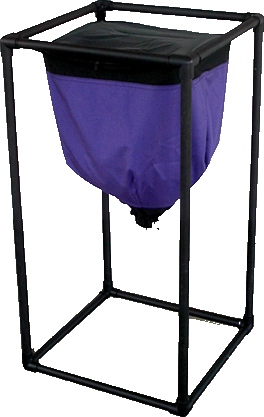Flow Through Worm Bin
Flow Through Vermicomposting Systems
Flow through worm
binsare fast becoming a favorite among worm farmers. Sometimes called continuous
flow bins or worm reactors the flow through systems was designed to overcome the disadvantages of traditional
worm bins. Vermicomposters often move on to a flow through system after starting out with traditional worm bins
or commercially produced stackable bin systems.
Traditional worm bins often end up with a
water logged muck of castings and bedding at the bottom making harvesting and clean up a mess. Flow through systems
have a distinct advantage when it comes to harvesting worm castings and when used properly are extremely easy to
maintain. These systems are so effective that commercial worm farms frequently use them.
Continuous flow bins take advantage of the
composting worm’s natural instincts to live within the first few inches of decomposing matter in the topsoil. In a
flow through bin system food is added to the top of the bin where the worms live and feed and their castings
are harvested from the opening in the bottom.
Flow through worm bins can be constructed
from any number of containers or handmade enclosures. Large buckets, garbage cans, old water heaters, and wooden
boxes can all be converted into a flow through worm bin. Other flow through systems are constructed commercially or
by worm farmers themselves.

Other flow through worm bin systems are simply made from canvas or heavy duty fabric hung upon a frame. The top is
left open and the bottom is tied off. Food and bedding are added from the top and castings are harvested from the
bottom.
Pictured here is the Worm Inn flow through
worm bin system. This is a simple and effective flow through system ideal for the home worm farming looking
for an easy to use flow through system.
How Flow Through
Bins Work
No matter how a flow through worm system is
constructed they all operate on the same basic principal. The bottom of the bin is open with a grid system
installed horizontally just above the bottom opening. The grid is designed to hold in bedding. The
grid may be constructed from a variety of materials including wire, PVC tubing, metal pipe
tubing. Before adding the intitial bedding and food sheets of paper or cardboard are placed on
top of the grids to prevent bedding and castings from falling through.
Composting worms are added from the top. As
the worms convert the bedding and food into casting the castings settle and compact at the bottom of the bin.
As the compacted vermicompost settles deeper into the bin more food and bedding is added from the top as
needed and the process continues.
When the compacted castings and compost begin
to build up and dry out it is harvested from the opening at the bottom of the bin. By this time the paper
or cardboard that was placed atop the grids have nearly decomposed and easily fall apart when harvesting
begins. From this point on the dry compacted vermicompost at the bottom of the bin is held in place
by the grid and harvested as needed.
Harvesting is accomplished by simply
loosening and removing the dry casting from the bottom of the bin and allowing it to fall through the grid for
easy collection. In a basic frow through systems a small shovel or rake loosens the
castings from the grid. In a more complex system the grid system is constructed from
tubing which can be turned and loosens the castings.
Larger and commercial flow through worm
bin systems have a breaker bar or blade installed just below the grid. The blade is as wide as the bottom
of the bin and is drawn across the drying castings and "shave" them off for collection.
Other Types of Flow
Through Worm Bins
Another type of flow through system is the horizontal flow
through worm bin. In these systems bedding is added to a long worm bin. Food and worms are added to one end of the
bin. As worms convert the food into castings more food is added along side the converted castings. The worms move
horizontally toward the food to eat it leaving more vermicompost and castings behind. Over time more food is added
and eventually the worms migrate across the bin following the food. Eventually the entire bin is filled with
castings or compost. At this point worms, castings, vermicompost, and cocoons are harvested and the process is
repeated.
Outdoor windrows or "vermitrenches" called walking windrows
utilize this same concept. However; this system is housed in the ground instead of a bin. So we
categorize this system as an windrow not a flow through system and will cover it in more detail in our ourdoor
bin pages.
Sometimes people call stacking worm bins a
flow through system. However we don't classify them as a true flow through system; we consider stacked systems a
category all their own. While it is true that stacking bins allow worms to migrate up to a higher bin as
food is eaten; each bin must be still be removed from the stack for harvesting. For more information
on stacking bin worm farms see our stacking bin page.
Flow through worm bins may be a bit
more complex to set up. But in the long run their ease of operation and simple harveting system make them a perfect
set up for both beginners and more advanced worm farmers.
Return to the top of flow through bin page.
|